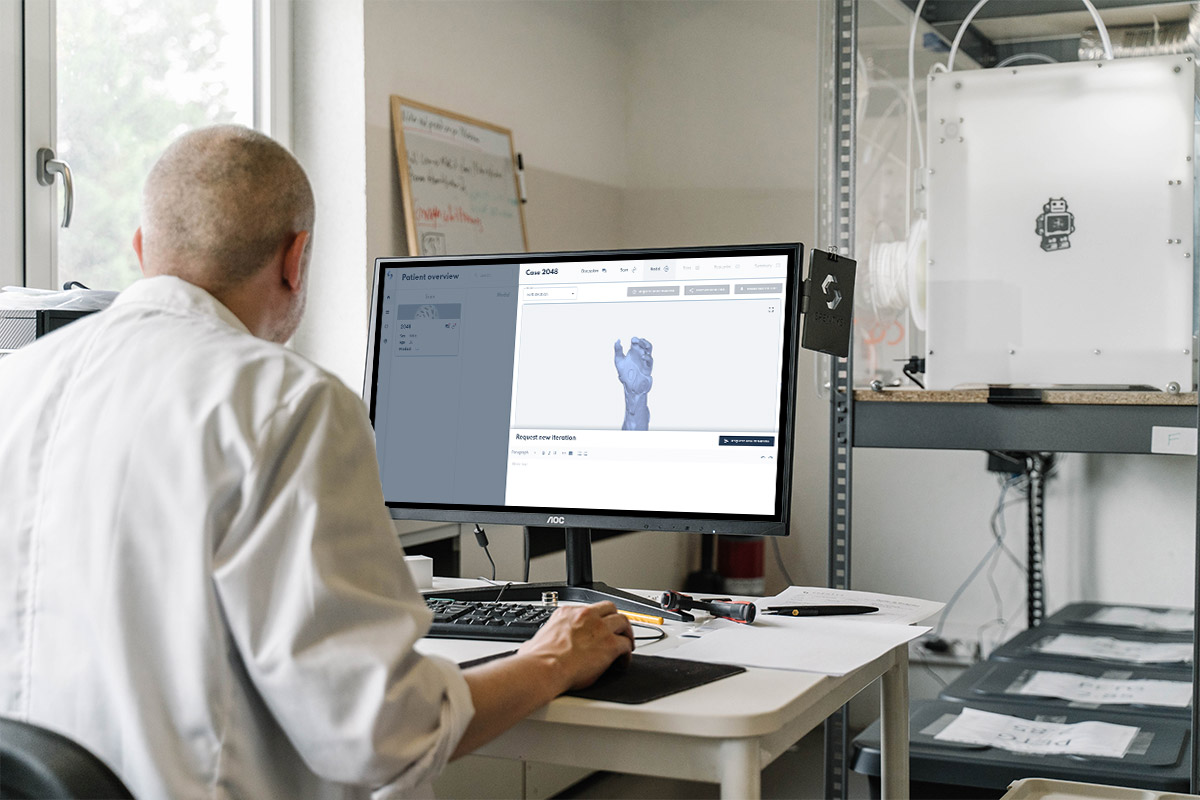Orthopedics and technology, a bright future or a gloomy one?
Orthopaedics is a medical speciality that annually generates billions of dollars. From diagnosis to surgery, medical experts try to solve all healthcare issues. As orthopaedic injuries rise in our medicalized society, so does the emergence of new advanced technologies for specific treatments. These two features will drive the growth of the orthopaedic devices industry.
A technology that has established itself as a proven method among orthopaedic surgeons is robotic surgery. This technique is less invasive (as it involves less and smaller incisions) and provides a more reproducible precision which will subsequently lead to faster recovery times. The Vinci Si, one of the most advanced surgical robots, has three robotic arms which allow a maximum range of motion and precision. The fourth arm of the robot contains a high definition 3D camera allowing the surgeon to position himself inside the patient's body, giving him an optimized 3D view of the surgical site. This technique might be efficient, but it is expensive and needs stronger evidence-based studies. Although robotic surgery might be expensive, more and more companies are investing in this technology.
It is important to reconsider future orientations and decide in which technology the orthopaedic industry wants to invest in.
Another interesting technology trend is orthobiologics. These are natural substances such as stem cells or bone grafts which are already present in the body but can be used for the healing process of bones, muscles, ligaments, tendons and many more. Progenitor cells develop to osteoblasts which evolve further into mature bone cells, thereby bone growth is promoted and the healing process of the branched bone is improved. Drug-eluting bone grafts are another application of orthobiologics; they are utilized to tackle issues such as surgical infection.
Smart sensor-enabled technologies and implants have been a regular presence in the orthopaedic sector for several years now. These implants provide direct information on the position and postoperative evaluation of the treatment in order to optimize patient’s care. These sensors contribute to the reduction of periprosthetic infections which is a prominent problem in orthopaedic surgery. Up until now, these sensors are mostly relying on built-in batteries, but recently new implants are being developed using friction to generate their own energy—an important feature for doctors to track the patient’s activity and lifestyle.
The main goal of the healthcare system remains the reduction of time and costs accompanied by the provision of optimized and personalized outcomes.
Yet another innovating technique used nowadays is augmented reality or mixed reality. This technology originated in the 1990s but has now gained the knowledge to impose itself as a well-established method for multiple orthopaedic applications. The superimposition of a computer-generated image on top of the actual visual field can be used in multiple settings like education, surgery and treatment purposes. It will be interesting to see if augmented reality can live up to its expectations.

The type of technology that is most likely to be recognized by the public is artificial intelligence (AI). The revival of neural networks is a type of AI that is often referred to as deep learning. Basically, AI applications in healthcare are a series of technologies that allow machines to sense, understand, predict, learn and execute. AI’s can easily detect structures or patterns in data and have already found purposes in the classification of humerus fractures and knee osteoarthritis. Concomitantly, questions in the medical world are not always easy to answer. They require more complex reasoning than a simple yes or no. The future of artificial intelligence is bright though, AI will expand beyond the algorithm-related tool it is today. It will become an essential tool for patients, healthcare professionals, doctors, and many others. AI offers the potential to really boost human activity.
Last but not least, 3D printing technology is transforming itself into an important stakeholder in the orthopaedic world. From customized implants to medical devices and orthotics, this additive manufacturing world has already profiled itself in several fields. Many metal 3D printed patient-specific implants are already being used by multiple orthopaedic surgeons because of the micropore structures. These textures ensure better attachment between the metal and the bone. At Spentys, we use 3D printing technology to deliver custom-made prostheses to the patient, which emphasizes the importance of additive manufacturing nowadays by supporting personalized healthcare.
Current technology trends are improving. In addition, experts are constantly developing technological novelties. It is important to reconsider future orientations and decide in which technology the orthopaedic industry wants to invest in. The main goal of the healthcare system remains the reduction of time and costs accompanied by the provision of optimized and personalized outcomes. Because the orthopaedic branch is in full development, a future with a combination of high-end and classic technologies seems inevitable.


Orthopedics and technology, a bright future or a gloomy one?

Orthopaedics is a medical speciality that annually generates billions of dollars. From diagnosis to surgery, medical experts try to solve all healthcare issues. As orthopaedic injuries rise in our medicalized society, so does the emergence of new advanced technologies for specific treatments. These two features will drive the growth of the orthopaedic devices industry.
A technology that has established itself as a proven method among orthopaedic surgeons is robotic surgery. This technique is less invasive (as it involves less and smaller incisions) and provides a more reproducible precision which will subsequently lead to faster recovery times. The Vinci Si, one of the most advanced surgical robots, has three robotic arms which allow a maximum range of motion and precision. The fourth arm of the robot contains a high definition 3D camera allowing the surgeon to position himself inside the patient's body, giving him an optimized 3D view of the surgical site. This technique might be efficient, but it is expensive and needs stronger evidence-based studies. Although robotic surgery might be expensive, more and more companies are investing in this technology.
It is important to reconsider future orientations and decide in which technology the orthopaedic industry wants to invest in.
Another interesting technology trend is orthobiologics. These are natural substances such as stem cells or bone grafts which are already present in the body but can be used for the healing process of bones, muscles, ligaments, tendons and many more. Progenitor cells develop to osteoblasts which evolve further into mature bone cells, thereby bone growth is promoted and the healing process of the branched bone is improved. Drug-eluting bone grafts are another application of orthobiologics; they are utilized to tackle issues such as surgical infection.
Smart sensor-enabled technologies and implants have been a regular presence in the orthopaedic sector for several years now. These implants provide direct information on the position and postoperative evaluation of the treatment in order to optimize patient’s care. These sensors contribute to the reduction of periprosthetic infections which is a prominent problem in orthopaedic surgery. Up until now, these sensors are mostly relying on built-in batteries, but recently new implants are being developed using friction to generate their own energy—an important feature for doctors to track the patient’s activity and lifestyle.
The main goal of the healthcare system remains the reduction of time and costs accompanied by the provision of optimized and personalized outcomes.
Yet another innovating technique used nowadays is augmented reality or mixed reality. This technology originated in the 1990s but has now gained the knowledge to impose itself as a well-established method for multiple orthopaedic applications. The superimposition of a computer-generated image on top of the actual visual field can be used in multiple settings like education, surgery and treatment purposes. It will be interesting to see if augmented reality can live up to its expectations.

The type of technology that is most likely to be recognized by the public is artificial intelligence (AI). The revival of neural networks is a type of AI that is often referred to as deep learning. Basically, AI applications in healthcare are a series of technologies that allow machines to sense, understand, predict, learn and execute. AI’s can easily detect structures or patterns in data and have already found purposes in the classification of humerus fractures and knee osteoarthritis. Concomitantly, questions in the medical world are not always easy to answer. They require more complex reasoning than a simple yes or no. The future of artificial intelligence is bright though, AI will expand beyond the algorithm-related tool it is today. It will become an essential tool for patients, healthcare professionals, doctors, and many others. AI offers the potential to really boost human activity.
Last but not least, 3D printing technology is transforming itself into an important stakeholder in the orthopaedic world. From customized implants to medical devices and orthotics, this additive manufacturing world has already profiled itself in several fields. Many metal 3D printed patient-specific implants are already being used by multiple orthopaedic surgeons because of the micropore structures. These textures ensure better attachment between the metal and the bone. At Spentys, we use 3D printing technology to deliver custom-made prostheses to the patient, which emphasizes the importance of additive manufacturing nowadays by supporting personalized healthcare.
Current technology trends are improving. In addition, experts are constantly developing technological novelties. It is important to reconsider future orientations and decide in which technology the orthopaedic industry wants to invest in. The main goal of the healthcare system remains the reduction of time and costs accompanied by the provision of optimized and personalized outcomes. Because the orthopaedic branch is in full development, a future with a combination of high-end and classic technologies seems inevitable.







_11zon.jpg)

